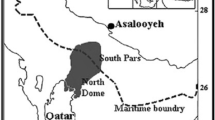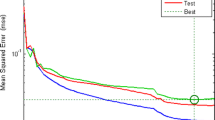Abstract
P- and S-wave impedances are accounted as two significant parameters conventionally inverted from seismic amplitudes for evaluation of gas and oil reservoirs. They may not be the final goal of interpretation studies; however, they play an important role in many methods such as reservoir characterization, rock physical modeling, geostatistical simulation, fluid detection. Bayesian inversion is a conventional method used by many researchers and even by industry to invert these parameters. To compare this method with intelligent methods, the adaptive network-based fuzzy inference system (ANFIS) was utilized to construct a model for the prediction of P- and S-wave impedances. Two ANFIS models were implemented, subtractive clustering method (SCM) and fuzzy c-means clustering method. The prediction capabilities offered by ANFIS models were shown by using field data obtained from a carbonate reservoir in Iran. Unlike other studies, input parameters, in this study, are pre-stack seismic data and attributes, while the P- and S-wave impedances are the output parameters in all methods. Mean square error was used for comparison of the performance of those models. The obtained results show that the ANFIS-SCM model generates the best indirect estimation of P- and S-wave impedances with high degree of accuracy and robustness.









Similar content being viewed by others
References
Farfour M, Yoon WJ, Kim J (2015) Seismic attributes and acoustic impedance inversion in interpretation of complex hydrocarbon reservoirs. J Appl Geophys 114:68–80
Karimpouli S, Hassani H, Nabi-Bidhendi M, Khoshdel H, Malehmir A (2013) Application of probabilistic facies prediction and estimation of rock physics parameters in a carbonate reservoir from Iran. J Geophys Eng 10(1):015008
González EF, Mukerji T, Mavko G (2007) Seismic inversion combining rock physics and multiple-point geostatistics. Geophysics 73(1):R11–R21
Tahmasebi P, Sahimi M (2015) Geostatistical simulation and reconstruction of porous media by a cross-correlation function and integration of hard and soft data. Transp Porous Med 107(3):871–905
Malehmir A, Durrheim R, Bellefleur G, Urosevic M, Juhlin C, White DJ, Milkereit B, Campbell G (2012) Seismic methods in mineral exploration and mine planning: a general overview of past and present case histories and a look into the future. Geophysics 77(5):173–190
Khalid P, Ahmed N, Mahmood A, Saleem MA (2015) An integrated seismic interpretation and rock physics attribute analysis for pore fluid discrimination. Arab J Sci Eng 41(1):1–10
Duijndam A (1988) Bayesian estimation in seismic inversion. Part i: PRINCIPLES1. Geophys Prospect 36(8):878–898
Ulrych TJ, Sacchi MD, Woodbury A (2001) A Bayes tour of inversion: a tutorial. Geophysics 66(1):55–69
Tarantola A (2005) Inverse problem theory and methods for model parameter estimation. SIAM, Philadelphia
Buland A, Omre H (2003) Bayesian linearized AVO inversion. Geophysics 68(1):185–198
Karimpouli S, Malehmir A (2015) Neuro-Bayesian facies inversion of prestack seismic data from a carbonate reservoir in Iran. J Pet Sci Eng 131:11–17
Zhao L, Geng J, Cheng J, D-h Han, Guo T (2014) Probabilistic lithofacies prediction from prestack seismic data in a heterogeneous carbonate reservoir. Geophysics 79(5):M25–M34
Grana D, Della Rossa E (2010) Probabilistic petrophysical-properties estimation integrating statistical rock physics with seismic inversion. Geophysics 75(3):O21–O37
Buland A, Kolbjørnsen O, Hauge R, Skjæveland Ø, Duffaut K (2008) Bayesian lithology and fluid prediction from seismic prestack data. Geophysics 73(3):13–21
Karimpouli S, Hassani H, Khoshdel H, Malehmir A, Nabi-Bidhendi M (2014) Detection of high quality parts of hydrocarbon reservoirs using bayesian facies estimation: a case study on a carbonate reservoir from Iran. Advances in data, methods, models and their applications in oil/gas exploration, pp 93–130
Jang JSR (1993) ANFIS: adaptive-network-based fuzzy inference system. IEEE T Syst Man Cybern 23(3):665–685
Fattahi H, Karimpouli S (2016) Prediction of porosity and water saturation using pre-stack seismic attributes: a comparison of Bayesian inversion and computational intelligence methods. Comput Geosci 20(5):1–20
Rezaee MR, Kadkhodaie Ilkhchi A, Barabadi A (2007) Prediction of shear wave velocity from petrophysical data utilizing intelligent systems: an example from a sandstone reservoir of Carnarvon Basin, Australia. J Pet Sci Eng 55(3):201–212
Zoveidavianpoor M, Samsuri A, Shadizadeh SR (2013) Adaptive neuro fuzzy inference system for compressional wave velocity prediction in a carbonate reservoir. J Appl Geophys 89:96–107
Ansari HR (2014) Use seismic colored inversion and power law committee machine based on imperial competitive algorithm for improving porosity prediction in a heterogeneous reservoir. J Appl Geophys 108:61–68
Golsanami N, Kadkhodaie-Ilkhchi A, Erfani A (2015) Synthesis of capillary pressure curves from post-stack seismic data with the use of intelligent estimators: a case study from the Iranian part of the South Pars gas field, Persian Gulf Basin. J Appl Geophys 112:215–225
Rajabi M, Bohloli B, Gholampour Ahangar E (2010) Intelligent approaches for prediction of compressional, shear and Stoneley wave velocities from conventional well log data: a case study from the Sarvak carbonate reservoir in the Abadan Plain (Southwestern Iran). Comput Geosci 36(5):647–664
Asoodeh M, Bagheripour P (2012) Prediction of compressional, shear, and stoneley wave velocities from conventional well log data using a committee machine with intelligent systems. Rock Mech Rock Eng 45(1):45–63
Mojeddifar S, Kamali G, Ranjbar H, Salehipour Bavarsad B (2014) A comparative study between a pseudo-forward equation (PFE) and intelligence methods for the characterization of the north sea reservoir. Int J Min Geo Eng 48(2):173–190
Aki K, Richards PG (2002) Quantitative seismology, vol 1. W H Freeman & Co., San Francisco
Chiu SL (1994) Fuzzy model identification based on cluster estimation. J Intell Fuzzy Syst 2(3):267–278
Bezdek JC (1973) Fuzzy mathematics in pattern classification. Cornell University, Ithaca
Malehmir A, Juhlin C, Wijns C, Urosevic M, Valasti P, Koivisto E (2012) 3D reflection seismic imaging for open-pit mine planning and deep exploration in the Kevitsa Ni-Cu-PGE deposit, northern Finland. Geophysics 77(5):95–108
Backus G (1962) Long-wave elastic anisotropy reduced by horizontal layering. J Geophys Res 67:4427–4440
Barnes AE (1996) Theory of 2-D complex seismic trace analysis. Geophysics 61(1):264–272
Tahmasebi P, Hezarkhani A (2011) Application of a modular feedforward neural network for grade estimation. Nat Resour Res 20(1):25–32
Tahmasebi P, Hezarkhani A (2010) Comparison of optimized neural network with fuzzy logic for ore grade estimation. Aust J Basic Appl Sci 4(5):764–772
Author information
Authors and Affiliations
Corresponding author
Rights and permissions
About this article
Cite this article
Karimpouli, S., Fattahi, H. Estimation of P- and S-wave impedances using Bayesian inversion and adaptive neuro-fuzzy inference system from a carbonate reservoir in Iran. Neural Comput & Applic 29, 1059–1072 (2018). https://doi.org/10.1007/s00521-016-2636-6
Received:
Accepted:
Published:
Issue Date:
DOI: https://doi.org/10.1007/s00521-016-2636-6




